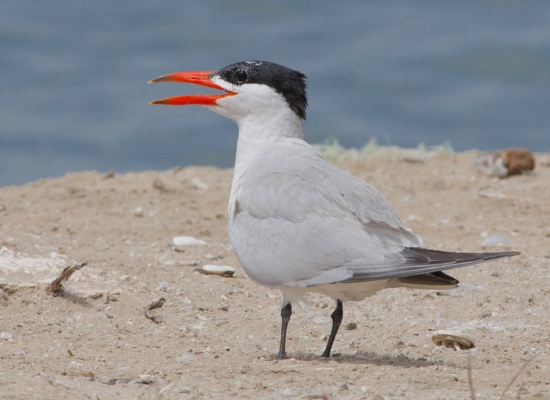(References updated) |
Nutcracker (talk | contribs) (more details) |
||
| Line 1: | Line 1: | ||
| − | [[Image: | + | [[Image:Caspian Tern, Gambia, Phil Watson.jpg|thumb|550px|right|Photo by {{user|Phil+Watson|Phil Watson}}<br />Adult summer, [[Gambia]], May 2014]] |
;[[:Category:Hydroprogne|Hydroprogne]] caspia | ;[[:Category:Hydroprogne|Hydroprogne]] caspia | ||
''Sterna caspia'' | ''Sterna caspia'' | ||
==Identification== | ==Identification== | ||
| − | 48–56 cm. | + | Length 48–56 cm, wingspan 127-140 cm, weight 570-780 g. The largest tern, 50% heavier than the next largest ([[Royal Tern]] and [[Great Crested Tern]]). White head, neck, belly, tail; cap is black in breeding plumage, mottled with white in winter and in juvenile, pale grey back and upper wings, pale, dark tipped underwings, black legs, bill massive, red with a blackish smudge near the tip. Juveniles with mantle and wings mottled brown and tail blackish, subadults (1-2 years old) similar but with reduced mottling. |
| − | [[Image:Caspian-tern-9012.jpg|thumb|350px|right|Photo by {{user|john-henry|john-henry}}<br />[[Portugal]], November 2008 ]] | + | [[Image:Caspian-tern-9012.jpg|thumb|350px|right|Juvenile in flight<br /> Photo by {{user|john-henry|john-henry}}<br />[[Portugal]], November 2008 ]] |
==Distribution== | ==Distribution== | ||
| − | [[ | + | Widespread but patchy breeding distribution in temperate and subtropical regions of [[Europe]] (north to 66°N in the Baltic Sea), [[Asia]], [[Africa]], [[North America]] (north to 62°N in the Great Slave Lake in Northwest Territories), [[Australia]] and [[New Zealand]]. Migratory in the temperate Northern Hemisphere, wintering south to the tropics (including the [[West Indies]] and northern [[South America]], where it does not breed); resident or dispersive in the subtropics and the temperate Southern Hemisphere. |
There are records most years for the [[British Isles]]. | There are records most years for the [[British Isles]]. | ||
| + | |||
==Taxonomy== | ==Taxonomy== | ||
| − | This is a [[Dictionary_M-O#M|monotypic]] species<sup>[[#References|[1]]]</sup>, in spite of its cosmopolitan range | + | This is a [[Dictionary_M-O#M|monotypic]] species<sup>[[#References|[1]]]</sup>, in spite of its near-cosmopolitan range. Some authorities formerly recognised two or three subspecies, with nominate ''H. c. caspia'' in the Old World, ''H. c. imperator'' in the New World, and ''H. c. strenua'' in Australasia. |
| − | + | It was in the past (and is still by some authorities) included in the genus ''[[:Category:Sterna|Sterna]]''. | |
==Habitat== | ==Habitat== | ||
| − | Large lakes and ocean coasts. Breeds on sandy coasts and islands. | + | Large lakes (fresh or salt water) and shallow, sheltered sea coasts; avoids exposed and deep-water ocean coasts. Breeds on sandy coasts and islands. |
<gallery> | <gallery> | ||
| − | Image: | + | Image:Caspian_Tern.jpg|Subadult<br />Photo by {{user|avesdigital|avesdigital}}<br />[[Tarifa]], [[Spain]]<br />Click on image to view larger version |
Image:Young larid.jpg|Juvenile<br /> Photo by {{user|blubird|blubird}}<br />Las Gallinas, [[California]], July 2008 <br />Click on image to view larger version | Image:Young larid.jpg|Juvenile<br /> Photo by {{user|blubird|blubird}}<br />Las Gallinas, [[California]], July 2008 <br />Click on image to view larger version | ||
</gallery> | </gallery> | ||
Revision as of 13:33, 6 June 2016
- Hydroprogne caspia
Sterna caspia
Identification
Length 48–56 cm, wingspan 127-140 cm, weight 570-780 g. The largest tern, 50% heavier than the next largest (Royal Tern and Great Crested Tern). White head, neck, belly, tail; cap is black in breeding plumage, mottled with white in winter and in juvenile, pale grey back and upper wings, pale, dark tipped underwings, black legs, bill massive, red with a blackish smudge near the tip. Juveniles with mantle and wings mottled brown and tail blackish, subadults (1-2 years old) similar but with reduced mottling.
Distribution
Widespread but patchy breeding distribution in temperate and subtropical regions of Europe (north to 66°N in the Baltic Sea), Asia, Africa, North America (north to 62°N in the Great Slave Lake in Northwest Territories), Australia and New Zealand. Migratory in the temperate Northern Hemisphere, wintering south to the tropics (including the West Indies and northern South America, where it does not breed); resident or dispersive in the subtropics and the temperate Southern Hemisphere.
There are records most years for the British Isles.
Taxonomy
This is a monotypic species[1], in spite of its near-cosmopolitan range. Some authorities formerly recognised two or three subspecies, with nominate H. c. caspia in the Old World, H. c. imperator in the New World, and H. c. strenua in Australasia.
It was in the past (and is still by some authorities) included in the genus Sterna.
Habitat
Large lakes (fresh or salt water) and shallow, sheltered sea coasts; avoids exposed and deep-water ocean coasts. Breeds on sandy coasts and islands.
Subadult
Photo by avesdigital
Tarifa, Spain
Click on image to view larger versionJuvenile
Photo by blubird
Las Gallinas, California, July 2008
Click on image to view larger version
Behaviour
Diet
The diet includes fish, insects, eggs and young birds.
Breeding
They are ground nesters, colonially and singly; 1-3 pale blue green eggs, heavily spotted brown, are laid in a bare scrape.
Vocalisation
The call is a loud croak.
<flashmp3>Sterna caspia (song).mp3</flashmp3>
Listen in an external program
References
- Clements, J. F., T. S. Schulenberg, M. J. Iliff, D. Roberson, T. A. Fredericks, B. L. Sullivan, and C. L. Wood. 2015. The eBird/Clements checklist of birds of the world: v2015, with updates to August 2015. Downloaded from http://www.birds.cornell.edu/clementschecklist/download/
- Wikipedia
- Collins Field Guide 5th Edition
- Collins Bird Guide ISBN 0 00 219728 6
Recommended Citation
- BirdForum Opus contributors. (2024) Caspian Tern. In: BirdForum, the forum for wild birds and birding. Retrieved 2 May 2024 from https://www.birdforum.net/opus/Caspian_Tern
External Links







